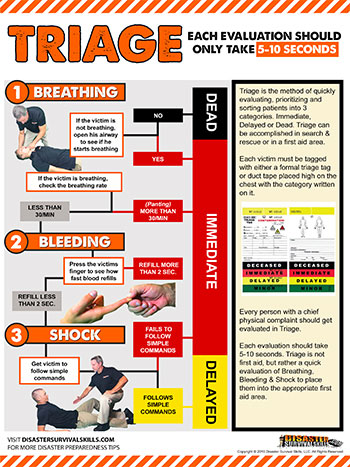In the event of a mass casualty from a disaster, your CERT teams or Emergency Response Teams should perform Triage on victims prior to first aid care. Our Triage Flowchart will enable rescuers to quickly evaluate, prioritize and sort patients into 3 categories; Immediate, Delayed and Dead. Giving priority care to those who need it most.
Mass casualty situations could be overwhelming when you are faced with more victims than the available resources can handle. This is where Triage comes in, this is the key to helping an overwhelming number of victims.
Triage comes from the french word that means “to sort“. Use Triage in emergencies where there are more victims than rescuers, limited resources and time is critical.
Rescue Team members will triage victims into 3 categories:
- Immediate – Victims who need immediate care, have life-threatening injury involving breathing problems, excessive bleeding or in a state of shock.
- Delayed – Victims who have injuries, but are not life-threatening. These victims still need care, but that care can be delayed while other victims with life-threatening injuries are treated first.
- Dead – Victims who are not breathing after 2 attempts of opening their airway. Unfortunately, in a mass casualty situation, there is not enough time or resources to perform CPR since this may prevent other victims from receiving immediate life-saving treatment.
Triage can be accomplished during search & rescue or in the first aid area. Each victim will be tagged with either a formal triage tag or some form of identification of the triage category. Every person with a chief physical complaint will get evaluated in Triage.
The goal of Triage is to identify victims who are having life-threatening problems. You may have heard me discuss these 3 major causes of death from disasters on one of my videos. I’ve prepared a free online training for this, that you can watch here.
However, triage is not first aid but rather a quick evaluation of Breathing, Bleeding, and Shock to place them into the appropriate category in the first aid area. So each evaluation should take 5-10 seconds.
How to Triage
For a more understandable format, I’ve made this very simple Triage Flowchart poster that you can print and put in your Disaster Survival Kits.
You can also download all posters here
Disaster Response Guide For Schools
While a Triage Flowchart is one vital part of your disaster response plan, there are other skills that your emergency team should know, like evacuation, types of equipment needed, team assignments, light urban search & rescue methods, disaster first aid, firefighting and utilities. To find out more about these step by step rescue guides, get your Emergency Response Team Members a Disaster Response Guide For School booklet.




